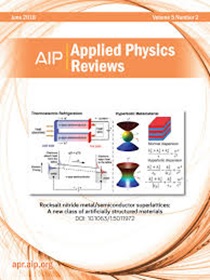Ultrafast laser-matter interaction mechanisms and applications in functional device fabrication: Recent advances and perspectives
IF 11.6
1区 物理与天体物理
Q1 PHYSICS, APPLIED
引用次数: 0
Abstract
The rise of high-performance functional devices has driven significant breakthroughs in various research fields, with ultrafast laser processing offering unprecedented opportunities for advanced device fabrication. This review summarizes recent progress and future prospects for ultrafast laser in fabricating functional optical, semiconductor, and sensor devices. Central to these advances is a deeper understanding of ultrafast laser–matter interaction physics, including nonlinear optical effects, multiphoton ionization, avalanche ionization, and laser-induced plasma dynamics. These phenomena govern carrier excitation, energy deposition, and subsequent structural modification. We further review how such interactions enable controlled refractive index changes, selective ablation, and nanoscale material structuring in photosensitive, dielectric, semiconductor, and metallic substrates. Key applications are then reviewed, including ultrafast laser fabrication of optical devices (e.g., optical waveguide devices, optical data storage elements, optical elements, and artificial compound eyes, integrated photonic devices), semiconductor devices (e.g., semiconductor light-emitting devices, photodiodes, solar cells, and photodetectors), and sensors (e.g., fiber optic sensors, flexible sensors, and biochemical sensors). Recent breakthroughs showcase ultrafast laser-induced precision in device miniaturization, improved optoelectronic characteristics, and integration of complex functions (e.g., topological photonic circuits fabricated via sub-100-nm laser writing, 5D optical data storage in glass with > 1 TB/cm3 density, perovskite solar cells achieving 25.7% efficiency through laser-induced phase engineering, alongside plasmonic biosensors with 100× sensitivity enhancement, and stretchable graphene sensors for wearables). Finally, this review discusses core challenges, such as enhancing the scalability of ultrafast laser processes for industrial-scale production and optimizing laser-material interactions to improve device reliability and performance. Future efforts should address key challenges such as the limited scalability of ultrafast laser processing and the incomplete understanding of laser–matter interactions at ultrafast timescales. Integrating ultrafast lasers with AI-driven control, beam shaping, and advanced materials such as 2D heterostructures may enable smarter and more multifunctional device platforms. A unified theoretical framework is also needed to guide precise and efficient fabrication. These directions highlight critical opportunities for bridging current limitations and enabling transformative advances. While not exhaustive, this review lays a foundation for further research into the transformative potential of ultrafast laser in functional device fabrication.超快激光-物质相互作用机制及其在功能器件制造中的应用:最新进展与展望
高性能功能器件的兴起推动了各个研究领域的重大突破,超快激光加工为先进器件制造提供了前所未有的机会。本文综述了超快激光在功能光学、半导体和传感器器件制造方面的最新进展及未来展望。这些进展的核心是对超快激光-物质相互作用物理的更深入理解,包括非线性光学效应、多光子电离、雪崩电离和激光诱导等离子体动力学。这些现象支配着载流子激发、能量沉积和随后的结构修饰。我们进一步回顾了这种相互作用如何在光敏、电介质、半导体和金属衬底中实现可控折射率变化、选择性烧蚀和纳米级材料结构。然后回顾了关键应用,包括光学器件的超快激光制造(例如,光波导器件,光数据存储元件,光学元件和人工复眼,集成光子器件),半导体器件(例如,半导体发光器件,光电二极管,太阳能电池和光电探测器)和传感器(例如,光纤传感器,柔性传感器和生化传感器)。最近的突破展示了超快激光诱导的器件小型化精度,改进的光电特性,以及复杂功能的集成(例如,通过亚100纳米激光写入制造的拓扑光子电路,5D光学数据在玻璃中存储&;gt;1 TB/cm3密度,钙钛矿太阳能电池通过激光诱导相位工程实现25.7%的效率,以及具有100倍灵敏度增强的等离子体生物传感器和可拉伸的石墨烯传感器。最后,本文讨论了核心挑战,如提高工业规模生产的超快激光工艺的可扩展性,优化激光与材料的相互作用,以提高器件的可靠性和性能。未来的努力应该解决一些关键挑战,比如超快激光加工的可扩展性有限,以及对超快时间尺度下激光与物质相互作用的不完全理解。将超快激光器与人工智能驱动的控制、光束整形和2D异质结构等先进材料相结合,可能会实现更智能、更多功能的设备平台。还需要一个统一的理论框架来指导精确和高效的制造。这些方向突出了克服当前限制和实现变革性进步的关键机会。虽然不详尽,但本文综述为进一步研究超快激光在功能器件制造中的变革潜力奠定了基础。
本文章由计算机程序翻译,如有差异,请以英文原文为准。
求助全文
约1分钟内获得全文
求助全文
来源期刊

Applied physics reviews
PHYSICS, APPLIED-
CiteScore
22.50
自引率
2.00%
发文量
113
审稿时长
2 months
期刊介绍:
Applied Physics Reviews (APR) is a journal featuring articles on critical topics in experimental or theoretical research in applied physics and applications of physics to other scientific and engineering branches. The publication includes two main types of articles:
Original Research: These articles report on high-quality, novel research studies that are of significant interest to the applied physics community.
Reviews: Review articles in APR can either be authoritative and comprehensive assessments of established areas of applied physics or short, timely reviews of recent advances in established fields or emerging areas of applied physics.
 求助内容:
求助内容: 应助结果提醒方式:
应助结果提醒方式:


